
Official Edgar Rice Burroughs Tribute and Weekly Webzine Site Since 1996 ~ Over 15,000 Webpages in Archive |

Official Edgar Rice Burroughs Tribute and Weekly Webzine Site Since 1996 ~ Over 15,000 Webpages in Archive |

Illustrations by Jeff Doten
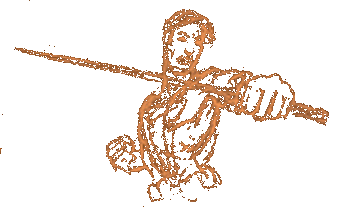 |
A few years ago, I was invited to a costume party. The theme of the party was science fiction, and I quickly decided that I wanted to go as Edgar Rice Burroughs' immortal hero John Carter (totally disregarding my lack of dark hair and gray eyes). I immediately went about constructing a harness and the appropriate apparels. |
| In the end, technical difficulties forced me to give
up and go as an intergalactic hitch-hiker (complete with towel, peanuts,
and Don't Panic pin) instead, but my interest in the subject of Barsoomian
clothing was awakened. It has since often struck me as strange how differently
various artists have interpreted the clothing of John Carter and his fellows,
and how different most of those interpretations are from my own mental
image. When looking at some illustrations, I find everything from Frank
Frazetta's near-naked men and women to the fully clothed Martians of Jesse
Marsh's comic book adaptation.
As was his wont, Burroughs never described in any detail the clothing of the fighting man of Mars. Indeed, he did not so much as mention the word "harness" throughout the first book (using instead the term "trappings"), and when he first did mention it, it was only in passing in the second chapter of The Gods of Mars. Nevertheless, scattered throughout the books are clues to the dress code of Barsoom. The purpose of this article is to examine those clues and present a picture of what harness and other pieces of clothing could possibly look like. The results should be useful as inspiration and guidance for artists, role players, miniature hobbyists, fan fiction authors, and other fans of Burroughs' amazing universe. Due to the scant descriptions in the novels this text is not, and was never intended to be, the final word on the subject. Each fan must still form his or her own subjective opinion. At best, the present text can give a push in the right direction. I have deliberately neglected much of the clothing that differs from the norm. This includes for instance the arctic clothing of the yellow men (see WM/8-9), as well as the peculiar headgear of the kaldanes (see CM/3-5). I have also left out most types of ceremonial clothing, such as wedding costumes. Perhaps these items can provide material for an article of its own or two. Strapping It OnThe universal piece of clothing on Barsoom is the harness. This is worn by men as well as by women; by green men as well as by red; in battle as well as on ceremonial occasions. There are, of course, different types of harness for different situations. For example, Tan Hadron relates the following about his harness:
This tells us not only that there are different types of harness, but also the material it is made of: leather. Unfortunately, we never learn anything more about specifically what kind of leather is used for harnesses, except that Tara's wedding harness in Manator "was of the white hide of the great white apes of Barsoom" (CM/22). We can only guess that most standard harnesses are made of thoat or zitidar skin. There are probably a large number of different harness designs. Some will be for riding, some for use on fliers; others yet will be for carrying a single weapon, or specialized for various occupations. From a mentioning of "women dressed in the harness of men" (FMM/13), we also know that men and women wear differently styled harnesses. For the purpose of this article, however, I shall assume that there is one basic type of harness, after which all other harnesses are modeled. I shall also assume that all races and all nations use the same basic harness, except where Burroughs explicitly says otherwise. Before we proceed to describe the harness in more detail, there is one other question that needs to be answered, namely the slightly controversial issue of nakedness. How much does the harness cover, and is it really the only piece of clothing worn? The second part of that question is the easiest to answer. Ulysses Paxton describes Ras Thavas thus: "He [...] was naked except for some rather plain and well-worn leather harness [...], and one great ornament, a collar" (MMM/1). There are several similar passages throughout the books, making it rather clear that the harness is indeed the only piece of actual clothing worn. In contrast, John Carter describes the morgors of Jupiter as wearing not only a harness "similar to that which we Barsoomians wear," but also "a G string" (JCM(SMJ)/1). (On the other hand, the hormads wear nets around their waists which Vor Daj mistake for "articles of apparel" (SMM/3) suggesting that loincloths may be in use in some parts of Barsoom. Or perhaps such nets look more like belts.) As for the question of how much the harness covers, it seems clear that some harnesses hide more than others. Phor Tak is described as "a man, whose harness was so scant as to leave him almost nude" (FMM/9). In contrast, we know that some straps are quite broad, an example being "the broad leather strap of [Tara's] harness where it passed over her left shoulder" (CM/13). In this context, it is interesting to note that the word "harness" as late as mid 19th century was normally used in the broader meaning of a man-at-arms' full armor. The current meaning, a contraption of interconnected straps to be worn upon the body, did not start to catch on until the late 19th century. It is quite possible that traces of the original meaning were still part of Burroughs' vocabulary. All this suggests to me the image that the harness functions almost as a piece of clothing, hiding parts of the body, such as a woman's breasts, rather well. This finds support in the text. For instance, when Gahan of Gathol admires Tara he sees "a rounded breast, part hid beneath its jeweled covering" (CM/1), and later in the same chapter is mentioned her "lithe body that the jeweled harness but inadequately covered". Regarding Tan Hadron's flight through U-Gor, he tells that "At first, I think the fellow facing Tavia did not realize that she was a woman" (FMM/15). Even though the sentence goes on to say that "the scant harness of Barsoom hides little and certainly did not hide the rounded contours of Tavia's girlish body," it still suggests that her harness (which was that of a man, incidentally) at least initially hid her femininity. If Tavia's harness was, even for a short time, in full daylight able to conceal the fact that she is a woman, it must have covered the genitalia. There is otherwise little evidence for that, but at one point we are told that Ras Thavas "removed the harness down to his waist" (MMM/1). There must thus have been parts of the harness below the waist, such as holster straps hanging down on the thigh, or why not a pair of straps going between the legs to form a jockstrap of sorts. We also know something about the bodily positions of the various harness straps. Carthoris fastens one of Thuvia's jewels "to the strap that crossed his great chest beneath which beat his loyal heart" (TMM/5). The harness straps also cross on the back and there is a strap between the shoulders. This we know because Tan Hadron first "took a firm hold upon Haj Osis' harness between his shoulders" and then "grasped [Sanoma Tora] firmly by the harness where the straps crossed upon her back" (FMM/12). It is nowhere mentioned that any straps cross over the chest. More generally, we know that at least parts of the harness must have been rather loose fitting. When John Carter falls from the secret tower of Matai Shang, "a loop of my tough, leathern harness caught upon one of the cylindrical stone projections in the tower's surface" (WM/5). Also, Carthoris declares his love for Thuvia as he "knelt at her feet, raising a bit of her harness to his lips" (TMM/14). This loose fit, however, certainly does not describe the entire harness. Before attending her fathers festivities, Tara's harness "had been adjusted to her figure" (CM/1), suggesting a somewhat tight fit. |
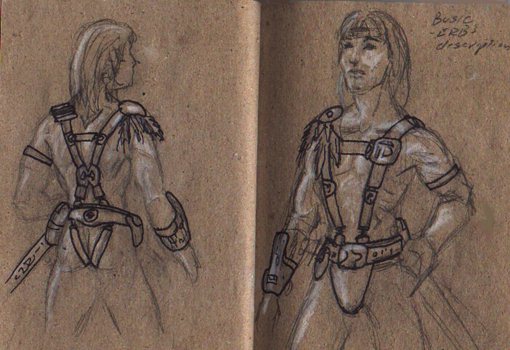
Basic Harness - this is straight from ERB's summarized descriptions. I don't consider it the last word though, as there is still so much unsaid. - Jeff |
| Can we use the above facts to re-create a typical harness?
Why, certainly! I imagine a harness consisting chiefly of two broad straps
and a belt. The straps run between the legs, where they are joined to form
the "jockstrap." Over the belly and chest, they run from the center of
the belt to each shoulder. On the back, they cross and then join the belt
above the buttocks. Apart from these there are several smaller straps,
such as one horizontally across the chest, one between the shoulder blades,
one for each weapon carried, one for a pocket pouch, etc. Some straps hang
loose, while others (the two main ones) are tightly fitted to the body.
There are indications that the straps of a harness added together are quite long. When freeing Xodar from Shador, John Carter was sitting on a 20 feet wall: "Unbuckling my harness I snapped it together with [sic] a single long strap which I lowered to the waiting Xodar below" (GM/13). Even though Xodar must have been standing, and possibly on his toes, to reach the connected strap, it must have been more than ten feet long. This is consistent with the design here specified. All in all, the two shoulder straps plus the belt total about ten feet on a large male specimen (namely myself; I happen to be almost exactly the same length as John Carter). Together with a few smaller straps it is more than adequate. |
Buckles, Rings, Hooks, and PocketsWhile we know a fair deal about the straps of the harness, we know somewhat less about how they are joined together. We do know that metal is used, since Phor Tak's metal-disintegrating ray causes a warrior's harness to fall off his body (FMM/1). It is clear that some kind of buckle is used to snap the straps together. The exact design of these buckles is anyone's guess, but the recurring term "snap" seems to suggest something more elaborate than just a hinged pin on a buckle frame -- perhaps the pin is attached to a steel spring. An additional clue is provided by Tan Hadron, as he utilizes a "prong of a buckle from my harness" (FMM/9), suggesting that the buckle pin is double or forked.Attached to the harness are also various rings and hooks. The use of the rings is unclear and the only example we have of one is when Gahan fastens a hooked tackle "to a ring in the warrior's harness" (CM/7). |
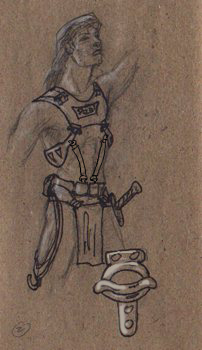
Flier harness with close-up of simple attachment. |
| The rings could be for use with such tackles when aboard
ships (in which case the rings would only be found on harnesses for use
on fliers) or they could serve some other, unknown, purpose. One possible
explanation is that rings instead of buckles connect harness straps that
are not supposed to be detached.
Regarding the hooks, the following quote will best describe
their use:
|
| John Carter uses such a boarding hook when climbing to
the roof of a building. That hook is said to be attached to the end of
"one of the long leather straps of my trappings" (PM/23). Again,
we see the term "snap," so the hook would probably be some fashion of snap-hook.
Hooks would normally only be found on flying harnesses.
Also attached to one of the harness straps, as mentioned above, will usually be a "leather pocket pouch such as all Martians carry" (LG-1/6). Such a pouch is apparently quite large and among "the heterogeneous collection of odds and ends that is always to be found in the pocket-pouch of a Martian warrior" (WM/3) will be objects such as money, pocket mirror, radium torch, spectacles, magnifying glass, concentrated rations, needle and thread, a folding jetan board, and the common Martian appliance for making fire. (The hard-core fan is herewith invited to try to remember where all these items are referenced in the books.) Some have more than one pouch, such as Ras Thavas who is more than once said to be carrying "pocket pouches" (MMM/1) upon his harness. There are sometimes also hidden pockets in the harness straps themselves. Tara has in her flying harness one or several pockets large enough to hold at least a key and "a long, slim blade" (CM/13). Showing One's ColorsWe know from several sources that one of the functions of the harness is to hold the insignia of the bearer's home city (or tribe, in the case of the green Martians), family house, social status, military attachment, and military rank. Regarding such insignia, however, Burroughs is even less generous with detail than otherwise.It is clear that some such insignia are made of metal. Green men, for instance, use "metal ornaments which denoted the tribes" (GM/3). Some green men have other ways to indicate their tribe. Bar Comas is "decorated with the breastplate of human skulls and dried dead hands which seemed to mark all the greater warriors among the Warhoons" (PM/18). A possible clue to insignia of military rank can be found in the descriptions of jetan pieces. Among these are "Panthans, which are represented as warriors with one feather, [...] the Thoats, mounted warriors with three feathers, [...] Warriors, foot soldiers with two feathers, [...] Padwars, lieutenants wearing two feathers, [...] Dwars, captains wearing three feathers" (CM/2). We also learn about a jetan odwar with "five brilliant feathers which denoted his position" (CM/17). Feathers are no longer used by most Martians, even though it is said about the Manatorians that "in their head-dress were many feathers as had been the custom of ancients" (CM/9). Even so, it is possible that modern Barsoomian insignia still show the heritage from the ancients. Military rank could well be denoted by a number of stylized metal feathers fastened to the harness, much as militaries on Earth wear metal angles and stars. One rare case where a piece of insignia is specified is when Tor-dur-bar's rank of a colonel among the hormads is shown by a "badge of office" (SMM/13), which is possibly hanging around his neck (the hormads appear to wear no harness). This, however, is probably not representative of most Barsoomian nations. Regarding the insignia for house and nation, we know of one case of a harness that carried "the insignia of the same house that appeared upon the bow of [a] flier" (WM/3). It is therefore possible that nationality and loyalty to a house are represented in the same way on a harness as on a ship, namely by colors. The term "colors" is here taken to be in the meaning of "flag." In this context, it is interesting to note how, in the midst of battle, John Carter's personal "colors broke from one of Zat Arrras' ships" (GM/20). Since it is unlikely that the ship would carry John Carter's personal flag, it is reasonable to believe that the prince is recognized by a combination of, say, three or four colors from the Barsoomian prism of nine. This "flag" would be easy to improvise on any warship of Barsoom, and the same color combination would then be used on the harnesses of soldiers and family members attached to John Carter's household. Unemployed panthans (soldiers of fortune) do not wear any insignia. "When their service is over they discard the metal of the nation they have been serving until they shall have found a new master. In the intervals they wear no insignia, their war-worn harness and grim weapons being sufficient to attest their calling." (TMM/11) |
Dressing UpFar from all ornaments on clothing and body serve a practical purpose. The black men, for instance, have harnesses "so encrusted with gold, platinum, silver and precious stones as to entirely hide the leather beneath" (GM/8) which they wear even when going to war.Not everyone is so richly decorated, but many harnesses are decorated to some extent. "Among the ornaments of Tars Tarkas' leather harness [...] was a small mirror, about the bigness of a lady's hand glass, which hung midway between his shoulders and his waist against his broad back" (GM/3), and we learn that Sola wears "metal breast ornaments" (PM/15) large enough to deflect a dagger. In some countries, feathers are used for decoration and have been known to be used in Manator (see above); by Lorquas Ptomel who wears "gay-colored feathers" (PM/4); and by the jeddak of Zodanga and his staff, who are even said to resemble "a band of the red Indians of my own Earth" (PM/21). |
| Bracelets, armlets, and anklets are very common
among both men and women. Most of these appear to be large and heavy, and
are usually described in terms such as "enormous" (PM/3) and "massive"
(e.g.
TMM/1). They can be either "plain" (TMM/2) or "of barbaric
magnificence" (CM/1). Their exact design is not known, but they
are often clasped in place.
A bracelet can sometimes serve a practical function. The jeddak of Manator has a "timepiece set in a massive bracelet upon his left forearm" (CM/22), and John Carter has one in "a cylindrical bracelet of gold" (WM/3). Another popular use of both bracelets and armlets is to reinforce a blow in unarmed combat. Armlets, bracelets, and anklets are also important in a social context since, among practically all races, the giving away of one is a sign of friendship or appreciation. |
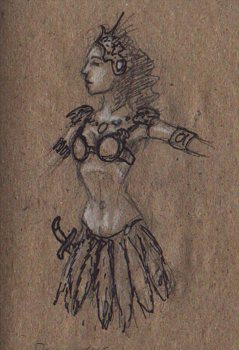
Formal Wear for a Heliumite Princess. This design features feathers hanging from the waist of her harness. |
It even appears that such pieces
of ornamentation can serve the same purpose, as do medals on Earth. The
following is a narration from a ceremony in Zodanga:
Other pieces of jewelry also exist. Burroughs mentions "a woman's hair ornament" (TMM/5); "a curiously wrought ring set with a dead-black, lusterless stone" (WM/9); and "a collar, jewel studded, that he wore around his scraggy neck--such a collar as a dowager empress of pork or real estate might barter her soul for, if she had one" (MMM/1). Helium After Dark"So rare is the atmosphere of Mars that it absorbs very little heat from the sun. During the daylight hours it is always extremely hot; at night it is intensely cold" (GM/5). Under such conditions, it is natural that clothing at day and at night is not the same. Therefore, it is common practice to wear "silk capes and robes of silk and fur for protection from the cold after dark" (GM/3). Silk as such naturally does not exist on Barsoom. The word is used figuratively to describe a silk-like material.The exact cut of these clothes is, as usual, not described in detail, but a few more general descriptions of clothes worn at night are given. A Holy Thern is clad in a "scarlet robe of office [...] pulled tightly about him in anticipation of the cold" (GM/5). When walking the garden of her father at night, Thuvia's "silks and furs were drawn about her" (TMM/2). In Manator, the guards wear "gorgeous robes against the chill of night" (CM/10). Therns are not the only white men to use robes. Lotharians are even during daylight hours "clothed in flowing robes" (TMM/6), as are their ancestors on the murals of Korad (PM/11). Among red men, the priests of Tur wear some kind of robe, "their entire bodies, including their heads and faces, covered by a mantle of white cloth" (MMM/10). While living with the Tharks, John Carter seems to be constantly clad in a cape. For instance, he uses "a piece of silk from my cape" (PM/10) to stop the blood when Dejah Thoris has been struck. Such capes seem to be common among the Tharks. Lorquas Ptomel wears "a short cape of white fur lined with brilliant scarlet silk" (PM/4). The cape as an apparel of clothing is never mentioned in direct connection with any race other than green men, but it is conceivable that capes are universally used, although probably only green men use them during the day. Red women sometimes wear scarf-like cloths. "A scarf of silken gossamer crossing over one shoulder was wrapped about [Tara's] body" (CM/1) before she put on her jeweled harness, and after Dejah Thoris had been carried away from the pits of the First-Born, "A silk lay upon the floor [...] as though torn from [its] wearer in a struggle" (GM/21). This type of garment seems to be inspired by the ancient Roman palla, which was worn by many women and which was sometimes made of silk. The robes and capes above are some of the very few cases where Burroughs specifies the actual color of a piece of clothing. In fact, the only colors that he does mention are red, yellow (only in the black-and-yellow striped orluk fur), white, and black. There is naturally nothing to say that other colors could not be used as well, and jewelry and other ornamentation should definitely reflect a multitude of colors. Equipment for the Fighting ManWhile this article is not primarily about weaponry, it is quite impossible to write about Barsoomian clothing without also mentioning the personal weapons. Indeed, no Barsoomian would ever go about unarmed, except perhaps within the walls of his own home, securely risen above ground.
A standard equipment of weapons consists of "a long sword, a short sword, a dagger and a pistol" (FMM/2). Of course, fewer weapons are sometimes carried, in particular by women or within city walls. Some warriors, on the other hand, have even more weapons, including extra daggers, extra pistols, and hatchets. Other weapons, such as rifles and spears, are usually fastened onto mounts or fliers and can thus not be considered as part of the clothing. However, extra ammunition for a rifle can sometimes be carried upon the harness. John Carter at one time has "another hundred [rounds] in the belt at my back" (PM/17), probably in a spare magazine strapped to the belt. About the Barsoomian dagger we know next to nothing. (On the other hand, there are only so many ways in which a dagger can be fashioned.) Likewise, we know very little about the pistol. In PM and GM, it is frequently referred to as a "revolver," so it must have some revolving part of the mechanism. The likeness with an Earthly revolver is amplified in the following quote: "The hammer fell with a futile click upon an empty chamber" (GM/7). Pistols are further described as "long" (CM/1) and they have "buttons on the grips" (GM/13) for triggers. We know somewhat more about the primary Martian weapon, the sword. The general design is like that of our swords of Earth. Carthoris places his hand "upon the pommel of his long-sword" (TMM/1) and Tan Hadron finds "a short sword with a beautifully ornamented hilt and guard" (FMM/7). Some, possibly all, swords are single-edged, for John Carter relates "a trick to preserve this keen edge during a combat, taking the blows of your adversary's weapon on the back of your blade" (SM/13). |
|||
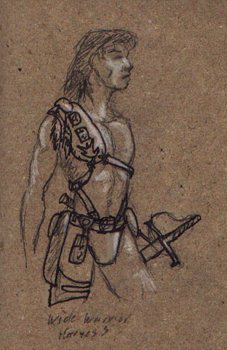
Wide warrior's harness with feather decorations on shoulder and metal inlays denoting rank. |
When fighting Zad, John Carter describes the
swords as "long, straight, needle-like" (PM/14). All swords are
not this thin. Outside Horz, for example, John Carter beats a thoat "with
the flat of my broadsword" (LG-1/4). Most swords are probably neither
needle-like nor broad, considering that they are used both for cutting
and thrusting. We are also fortunate enough to know the almost exact length
of one blade, since one of John Carter's adversaries goes down "with my
blade buried to the hilt in his breast and three feet of it protruding
from his back" (GM/7), suggesting a total blade length of just over
forty inches.
These facts taken together, the general design; the straightness; the single edge; the length and breadth, all seem to suggest a sword rather much like some of the military rapiers that were popular in 18th century Europe. This image is reinforced by the usual Martian fighting style, such as fighting without any heavy shield, armor or auxiliary left-hand weapon. |
||
| It is evident from several passages
that the Martian warrior's weapons usually hang by his sides. For instance,
John Carter on one occasion wears "at one side an ornate short-sword and
at the other a pistol" (CM/Prelude). Of course, it seems cumbersome
to wear four or five weapons all at the sides, but it is possible that
the word "side" is sometimes used figuratively. Pistols or daggers can
then hang from other parts of the harness, such as the chest straps or
the back of the belt.
As could be expected, swords and daggers that are not in use are protected by scabbards, and pistols are similarly encased in holsters. These are never described in detail, except to note when their leather is "completely hidden beneath ornaments of platinum thickly set with brilliant diamonds" (CM/1). From Top to ToeFew Martians wear anything on their heads. Even so, the very first time a full-grown Martian is described (Tars Tarkas, of course), he is noted for "the ornaments strapped upon his head, limbs, and breast" (PM/3). It is never described exactly what the ornaments on his head are; perhaps they are just feathers, perhaps some kind of fillet.The headdress of the Orovars is worth mentioning, especially
since it is one of very few times that Burroughs describes any piece of
clothing in detail:
|
|||
| Helmets are practically never
used on Barsoom, although it seems that they used to be. One of the embalmed
bodies below Horz "wore a helmet entirely covered with diamonds, one of
the few helmets I had ever seen upon Mars" (LG-1/5). This is the
only time a helmet is mentioned in the entire series.
Another piece of headgear, which is also mentioned only once, is the mask. The groom at the royal wedding in Manator wears "a grotesque mask of [gold] in which two enormous rubies were set for eyes, though below them were narrow slits through which the wearer could see" (CM/22). This mask, incidentally, was an important plot device and should in general be considered as very atypical of Barsoom. Members of royalty in red nations sometimes wear a diadem, apparently the Martian equivalence of a crown. The jetan piece Chief has "a diadem with ten jewels" (CM/2) and the Princess has a "diadem with a single jewel" (Ibid.). The jeddak of Invak wears "a diadem of carved leather upon the front of which the Barsoomian hieroglyphs which spelled jeddak were emblazoned in precious stones" (LG-4/4). If headgear is uncommon among red and green men, it is the more common among black and white. Both First Born nobles and Holy Therns have "upon their foreheads the insignia of their rank set in circlets of gold" (GM/11). In the case of the Holy Therns, this insignia consists of "an immense stone" (GM/4) scintillating the nine rays of the Barsoomian prism. The Martian is now almost completely described from top to toe. The only part left is the feet. Green men and therns in fact do not appear to wear anything at all upon their feet. The term "naked feet" is used to describe both thern guards in the Otz mountains (GM/3) and green men of southern Warhoon (GM/14). Red men, in contrast, mostly wear sandals and the only times when they are said to go bare-footed are when they have taken off their sandals for some special purpose. These sandals are usually made of "zitidar hide" (e.g. CM/19) and have soft soles. When moving stealthily, they give forth "no sound" (CM/13). They are easily removed, as proven by Carthoris when he "kicked off his sandals" (TMM/8) to better brace himself from sliding into the trap door of the throne room in Lothar. Some Final WordsFor a summary of sorts, I will end by giving a few brief guidelines to the reader who wishes to make a more practical use of the information in this article.For the typical Barsoomian, go for a harness, a pair of sandals, and a few armlets and anklets. No pants, no cape, nothing upon the head. It is also usual to have a full set of weapons at the sides: pistol, short sword, long sword, and dagger. Harness, scabbards, and other details may or may not be "beautifully wrought" and "ingeniously set with precious stones" (PM/4). A woman is clad the same, but with fewer weapons and minor differences in harness design, and she may also wear a large "scarf." Unless the person be a panthan, there will be some kind of insignia on the harness. If you want the typical green man, remove the sandals and add a short cape. If you want a typical thern, remove the sandals and add a circlet of gold upon the head. If you want a typical black man, add the same kind of circlet and an enormous amount of jewels upon the harness. This is the point where facts end and imagination begins. The present text (minus my own speculations) I daresay covers more or less every important detail Burroughs ever wrote regarding Barsoomian clothing. Of course, all that is not nearly detailed enough if you want to draw a picture, make your own fancy dress, or paint a miniature soldier. The rest will have to be filled in by yourself, and this is part of the fascination of Burroughs and his worlds: very little is actually given, and very much is left to the reader's own mind. Finally, if you find this article useful in any way, I would love to hear about it and, if possible, to see the results. Please do not hesitate to drop me a line at ekman@lysator.liu.se. |
|||
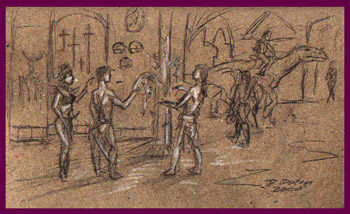
Barsoomian Harness Shop. |
|
| I've gained two things concerning Martian
gear. One is an awareness of why I've never had a clear image. The second
is a new and somewhat different image from what I held before.
This new image has made a permanent mark on my mental and real world canvas. I've always wanted to know, from that very first reading of A Princess of Mars, "what's it like?" ERB has been frustratingly short on details. I suspect that if I'd had the chance to sit down with ERB and sketch, he'd have some distinct ideas, and sometimes he'd say, "you tell me." There is so much that I did not do. I didn't do any "jeweled harness" or Thuvia's "hide the curves" outfit. I kept everything at the sketch stage too. I'd like to really lay out typical harnesses for warriors, royalty, cavalry, airships, shop keepers... Maybe in time. I consider what I have done to be the early work towards that goal. As Fredrik has said, a lot is still left to your imagination, which is not a bad thing. Many thanks Fredrik for helping me gain a clearer image of Barsoom. - Jeff Doten |
|
SourcesQuotes have been taken from the following books in the Martian series by Edgar Rice Burroughs. References are given using the same standard as in J. F. Roy's A Guide to Barsoom, with abbreviation of the title and number of the chapter where the quote is taken from.
About the Author and ArtistThe author and artist are both members of the Barsoom mailing list, which is how they became acquainted.Fredrik Ekman is a professional freelance writer from Linköping, Sweden. His usual field of competence is computers and networking, and he has written for some of Sweden's major computer magazines. Although a Burroughs reader since childhood, he did not discover the Barsoom novels until adult age. He is currently (September 2000) working on an article about the language of Barsoom. Jeff Doten is a professional artist living in Calgary, Alberta, Canada. He specializes in SF and Fantasy art. Among his clientele is the Royal Tyrrell Museum of Palaeontology, Edge Books, and an upcoming fantasy series from Padwolf books. As a lifelong Edgar Rice Burroughs fan, beginning with At the Earth's Core, recent Burroughs projects include Moon Maid artwork for ECOF 2000. He has recently opened a Barsoom gallery on his web site, Jeff Doten's Illustration Studio and begun OKAR - the Canadian Edgar Rice Burroughs Network. |
![]()
![]()
Volume
0438

BILL
HILLMAN
Visit
our thousands of other sites at:
BILL
AND SUE-ON HILLMAN ECLECTIC STUDIO
All
ERB Images© and Tarzan® are Copyright ERB, Inc.- All Rights Reserved.
All
Original Work © 1996-2004/2010/2024 by Bill Hillman and/or Contributing
Authors/Owners
No
part of this web site may be reproduced without permission from the respective
owners.